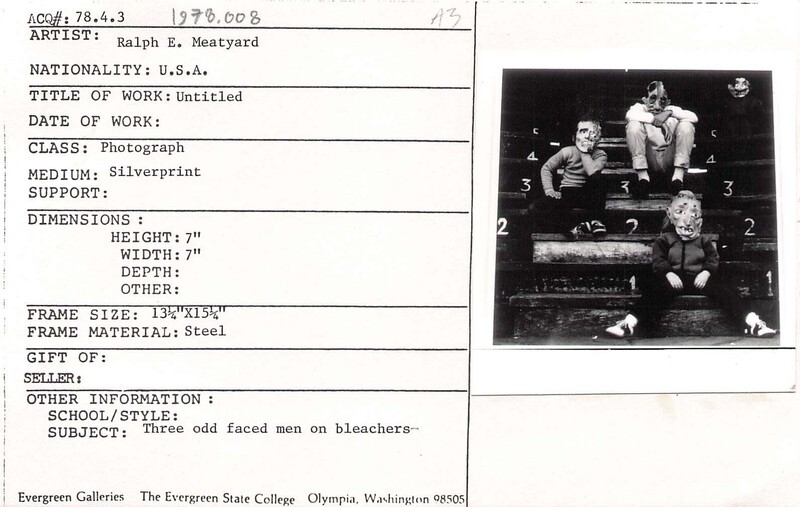-
Title
-
Christopher Meatyard
-
Creator
-
Ralph E. Meatyard
-
Artist ID
-
103
-
Description
-
Four odd faced men on bleachers
-
Category of Media
-
Photograph
-
Media
-
Silverprint
-
Accession Number
-
1978.008
-
Location
-
storage gray cabinet
-
Date Acquired
-
1978
-
Dimensions of Work
-
7" x 7"
-
Frame Dimensions
-
15.25" x 13.25'
-
Frame Type
-
Steel
-
Donor ID
-
131
-
Artist Bio
-
Ralph Eugene Meatyard (May 15, 1925 – May 7, 1972) was an American photographer, from Normal, Illinois. Meatyard was born in Normal, Illinois. After his marriage to Madelyn McKinney, he moved to Lexington, Kentucky, to continue his trade as an optician, working for Tinder-Krausse-Tinder, a company that also sold photographic equipment. The owners of the company were active members of the Lexington Camera Club, for which the Art Department of the University of Kentucky provided exhibition space. Meatyard purchased his first camera in 1950 to photograph his son, Michael, and worked primarily with a Rolleiflex medium-format camera ever afterwards. He eventually found his way to the Lexington Camera club in 1954, and at the same time joined the Photographic Society of America. It was at the Lexington Camera Club that Meatyard met Van Deren Coke, an early influence behind much of his work. Coke exhibited work by Meatyard in an exhibition for the university entitled “Creative Photography” in 1956. During the mid-1950s, Meatyard attended a series of summer workshops run by Henry Holmes Smith at Indiana University and also with Minor White. Minor White, in particular, fostered Meatyard’s interest in Zen Philosophy. An autodidact and voracious reader (it was said that he read books while driving), Meatyard made work in productive bursts, often leaving his film undeveloped for long stretches, then working feverishly in the makeshift darkroom in his home. “His approach was somewhat improvisational and very heavily influenced by the jazz music of the time.” Using his children as props to explore what could be called his prime subject, Meatyard addressed the surreal “masks” of identity and the ephemeral nature of surface matter. Much of his work was made in abandoned farmhouses in the central Kentucky bluegrass region during family weekend outings and in derelict spaces around Lexington. Some of his earliest camera work was made in the traditionally African American neighborhood around Lexington’s Old Georgetown Street. Meatyard was a close acquaintance of several well-known writers in the Kentucky literary renaissance of the 1960s and 70’s, including his neighbor Guy Davenport, who later helped put together a posthumous edition of his photos. The photographer co-authored a book on Kentucky’s Red River Gorge, The Unforeseen Wilderness, with writer Wendell Berry. The two took frequent trips together into the Appalachian foothills. Berry and Meatyard’s book was a major contribution to saving the gorge from destruction by a proposed Army Corps of Engineers dam. Meatyard’s ashes were scattered in the gorge after his death from congenital heart failure at the age of 46. Passing away himself just four years later, Meatyard’s early death “came at the height of the ‘photo boom’, a period of growth and ferment in photography in the United States that coalesced with the political and social upheavals of the 1960s and 1970s.” Though Lexington was a relative photographic backwater, Meatyard did not consider himself a “Southern” or regional photographer. His work was just beginning to be recognized nationally at the time of his death. Source: Wikipedia



